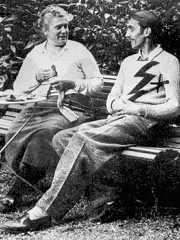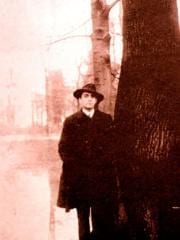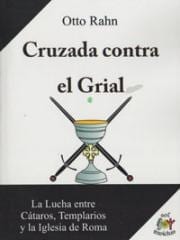Wolfram von Eschenbach
Otto Rahn y la Búsqueda Nazi por el Secreto de los Cátaros
La Berlin de entreguerras era una ciudad conocida en toda Europa por su sub-cultura bohemia y sus jovenes intelectuales. Entre los personajes que ardientemente celebraban los abundantes «ismos» que estaban fracturando las viejas certezas ideologicas, las cuales habian compactado el siglo XIX, pocos individuos eran mas coloridos que un joven de ojos verdes y cabellos oscuros llamado Otto Rahn. Su figura delgada, envuelta en un caracteristico abrigo negro y sombrero tiroles, arrojaba una larga sombra desde esos anos sombrios, una «gran silueta» alrededor de la cual se han acumulado los mitos mas extravagantes. El fue considerado igualmente como mason, rosacruz, luciferino, y un agente de la Sociedad Thule. Como lo plantea el autor Phillip Kerr, los contemporaneos de Rahn no se habrian sorprendido de ver «la Dama Escarlata y la Gran Bestia salir volando desde la puerta del frente» de su apartamento en Tiergartenstrasse. Uno de sus companeros de la Orden Negra de Heinrich Himmler comento en un memorandum interno que el «medio sospechaba que Rahn tenia relaciones con el pueblo pequeno».
Lachrymae, Chapter IV: The Final Chapter
An Online Journal by Richard Stanley<
(Originally appeared in R. S.' MySpace<, December 9th, 2007.)
Brethren, I have invited you here to this ancient, invisible theatre with the intention of not only unmasking the killer God responsible for these crimes against 'reality', but more cogently, to provide an unambiguous solution to two or perhaps three long running esoteric enigmas!
I salute those who have stayed with the program from the top. For late joiners I include an index to conjure order out of the scrolling chaos and serve as an aid memoir for those hardy few who dare read further. I have very little keyboard time at present and less in the months to come. Until we meet again this strange saga is my gift to you.
Be warned the completed text contains 'spoilers' and may be hazardous to your belief systems.
Otto Rahn: las conexiones entre catarismo y nazismo
UNA DE LAS FIGURAS que más fascinación ha ejercido en relación al mundo “neocátaro” es Otto Rahn, que buscó el Santo Grial en la fortaleza de Montségur. Miembro de las SS que acabó expulsado de sus filas, dejó una obra escrita breve pero influyente en el entorno hitleriano al amalgamar nazismo y catarismo. Sabemos muy poco de él, pues su trayectoria está rodeada de toda suerte de especulaciones. Y es que su personalidad fue harto chocante: francófilo y al parecer homosexual, se desenvolvió en un universo nazi pangermánico y exaltador de la virilidad.
Así las cosas, los interrogantes sobre Rahn son numerosos, abarcan todos los órdenes de su vida y tienen difícil respuesta con las fuentes disponibles: ¿Fue un estudioso del catarismo o lo empleó como pretexto para labores de espionaje? ¿Actuó como un nazi convencido o su condición de homosexual y la falta de medios le llevaron a las filas de las SS? ¿Murió en 1939 o se orquestó una farsa para “blanquear” sus supuestos ancestros judíos? Al margen de sus móviles, sabemos con certeza que nazificó el catarismo y mereció la atención y la complacencia del máximo dirigente de las SS, Heinrich Himmler.
Otto Rahn: author, poet, Grail seeker, SS officer
In February 2007, Montserrat Rico Góngora published “The Desecrated Abbey”, in which he claimed that Heinrich Himmler, Hitler’s second-in-command and head of the Nazi SS, had made a secret wartime mission to an abbey in Spain, in search of the Holy Grail. Góngora even interviewed Andreu Ripol Noble, a former monk and the only person that spoke German, who was ordered by his superiors to guide Himmler during the visit in 1940. Ripol related that Himmler came to Montserrat inspired by Richard Wagner’s opera “Parsifal”, which mentions that the Holy Grail could be kept in “the marvellous castle of Montsalvat in the Pyrenees” – the mountain range that marks the border between France and Spain.
Il neopaganesimo di Otto Rahn
Il caso di Otto Rahn è ormai noto: è la storia di un giovane romantico, che insegue un sogno. Un giorno entra in contatto con un potere sensibile al mito – il Terzo Reich -, che lo lancia e lo valorizza: ciò che presto lo porta a credersi una specie di nuovo cavaliere templare. Il mito del Graal, quello di una società di puri e di idealisti, di un regno dello spirito, popolava il suo immaginario. Certo del legame storico tra l’eresia dei Catari e la poesia dei trovatori medievali, l’una è l’altra viste come sopravvivenza pagana sotto la scorza del cristianesimo ufficiale, Rahn si convinse che il fulcro di questa cultura si fosse trovato un tempo nel castello provenzale di Montségur, alle pendici dei Pirenei. Proprio il luogo dove, nel 1244, avvenne il finale sterminio dei Catari da parte della Chiesa. In questa zona, intorno al 1929, Rahn svolse ricerce, percorse grotte e camminamenti, rintracciò graffiti e interpretò simboli arcani. Alla fine raccolse il tutto e scrisse il celebre libro Crociata contro il Graal, pubblicato nel 1933. L’incontro fatale con Himmler, anch’egli interessato alla storia delle eresie e all’universo dei simboli pre-cristiani, il pronto arruolamento e la rapida ascesa nelle SS, portarono però Rahn a inciampare nel suo piccolo-grande segreto. Sembra infatti che una mal vissuta omosessualità sia stata all’origine delle sue dimissioni dall’Ordine Nero nel 1938 e infine del suo suicidio, avvenuto per congelamento tra le montagne del Tirolo, nel marzo del 1939. Rahn rimase vittima di un trauma, per esser stato coinvolto in un piccolo scandalo omoerotico? Non resse il clima ideologico delle SS? Venne forse spinto a quel gesto? O ci arrivò da solo, per evitare l’isolamento sociale e magari la persecuzione?
Otto Rahn im Wikipedia
Otto Wilhelm Rahn (* 18. Februar 1904 in Michelstadt im Odenwald; † 13./14. März 1939 bei Söll (Tirol), Österreich) war ein deutscher Schriftsteller, Mediävist und Ariosoph,[1] der sich mit dem Gralsmythos beschäftigte.
Leben
Schule und Studium
Rahn wurde 1904 in Michelstadt/Odenwald als erstes Kind des Justizamtmanns Karl und Clara Rahn (geb. Hamburger) geboren. Ab 1910 besuchte er das humanistische Gymnasium erst in Bingen, wo er bis zum Beginn des Ersten Weltkriegs lebte. Sein Abitur machte er in Gießen. Dort begeisterte ihn sein Religionslehrer Freiherr von Gall erstmals für die Geschichte der Katharer. 1922 begann Rahn ein Jurastudium in Gießen, das er an der Albert-Ludwigs-Universität Freiburg und der Universität Heidelberg fortsetzte. 1925 bis 1928 unterbrach er sein Jurastudium und betätigte sich als Handelsreisender für verschiedene Verlage.
Prologo de Cruzada contra el Grial, La lucha entre Cátaros, Templarios y la iglesia de Roma
Wolfram von Eschenbach nos informa que Kyot, "el famoso Maestro", trajo a suelo germano la verdadera leyenda del Graal desde la Provenza; y que Chrétien de Troyes (el autor del Parsifal galo, o el Conde del Graal) la modificó. Si bien es cierto que no existe poema épico alguno acerca del Graal escrito por "Kyot", sabemos que a finales del siglo XII un poeta francés de la Provenza de nombre Guyot recorría las cortes más renombradas del norte y sur de Francia; y que entre sus poemas se encontraba una "Biblia" en la que caricaturizaba a sus contemporáneos. Resulta posible atribuir a este Guyot una versión del Parsifal que jamás llegó a nuestras manos.
Croisade contre le Graal
Si le Graal est un symbole phare — aussi mystérieux que fascinant — de la mythologie et de l’inconscient collectif européens, Croisade contre le Graal appartient à la famille — peu nombreuse — des ouvrages mythiques, des livres cultes. Depuis sa parution (1933 en Allemagne, 1934 en France), il a guidé des générations de rêveurs vers les cimes ariégeoises, en général, et le château de Montségur, en particulier. Régulièrement réédité des deux côtés du Rhin, il est régulièrement épuisé et recherché. Adversaires et partisans des thèses développées par Otto Rahn, tous s’accordent sur un point: Croisade contre le Graal a largement contribué à l’engouement touristique pour les Pyrénées cathares.
What is the Grail?
The Grail. Between 1190 and 1240, it formed the central theme of a series of literary works that spoke of, and appealed to, a new social class, that of the knights and warriors and the adventures they encountered on their travels. In recent decades, it unleashed Indiana Jones on one of his death-defying treasure hunts and was the central ingredient of Dan Brown’s The Da Vinci Code, one of the biggest bestselling novels ever.
For Richard Barber, in The Holy Grail: The History of a legend, “it is, in all its forms, a construct of the creative imagination”. However, for dozens of other authors, the Grail is not a literary invention, but a veritable treasure, out there, somewhere. Unfortunately, in general, studies trying to identify and trace the physical Grail have taken on flights of fancy. The Grail has been linked with countries from the Middle East to America, as well as with the persecuted Cathars and even extra-terrestrial beings. It has been labelled a code word for the Ark of the Covenant, after the Templars allegedly transported it from the Middle East to a new hiding place in France.
Otto Rahn: A Hero's Journey
I recently visited the former South of France residence of the legendary Grail hunter Otto Rahn, only to discover that it was scheduled to be demolished, thus ending an era, and prompting this memorial.
I believe Otto Rahn (1904-1939) was a hero; the real Indiana Jones and prototype for Dan Brown’s Robert Langdon character. A tireless explorer, Rahn was a gifted researcher, committed to the quest like no one before, or since. Quite simply, he was a grail hunter extraordinaire.
Rahn was obsessed with the Cathars, and was convinced that their treasure remained hidden in the shadowy crevasses of the Pyrenees. His research led to Montségur, which he believed to be Munsalvaesche, the Mountain of Salvation of Wolfram von Eschenbach’s epic grail romance, Parzival. Not surprisingly, the entire region around Montségur soon became Rahn’s esoteric playground.











Последние комментарии
13 лет 41 неделя назад
13 лет 42 недели назад
13 лет 42 недели назад
13 лет 42 недели назад
13 лет 45 недель назад
13 лет 51 неделя назад